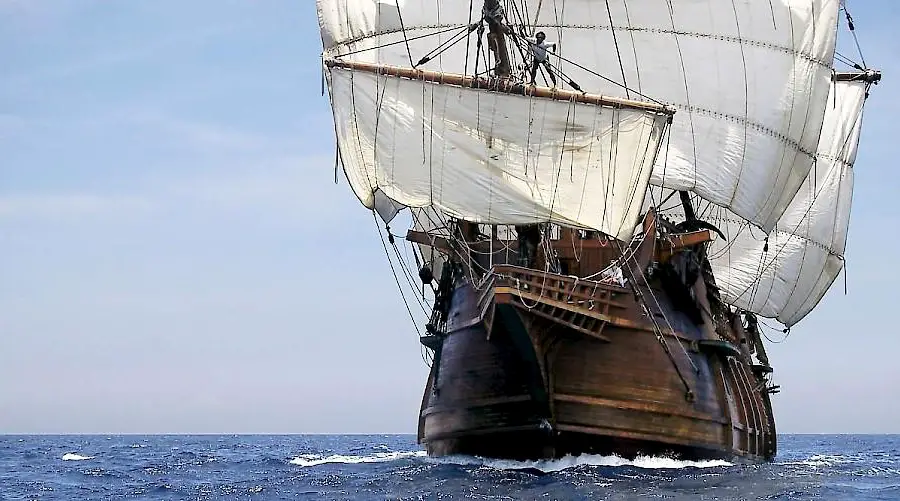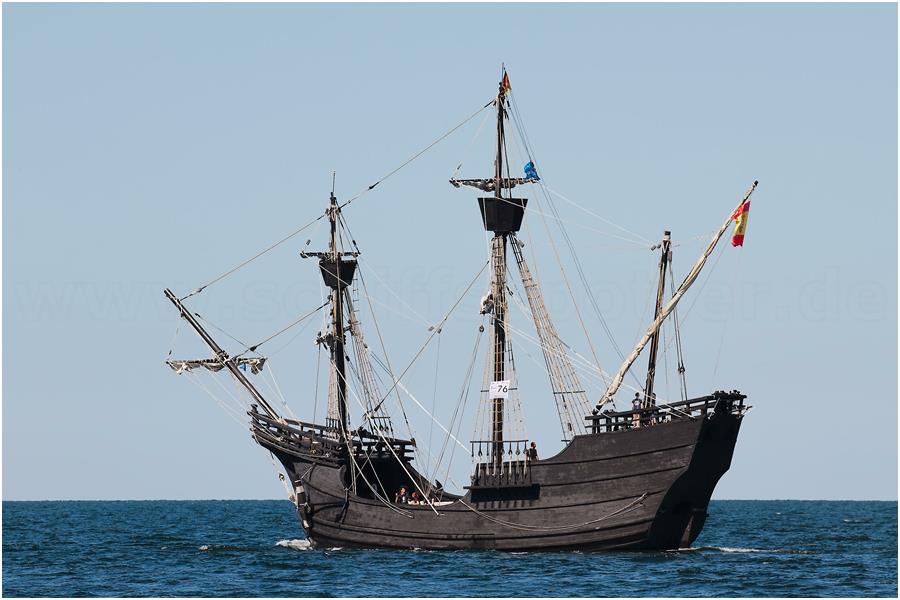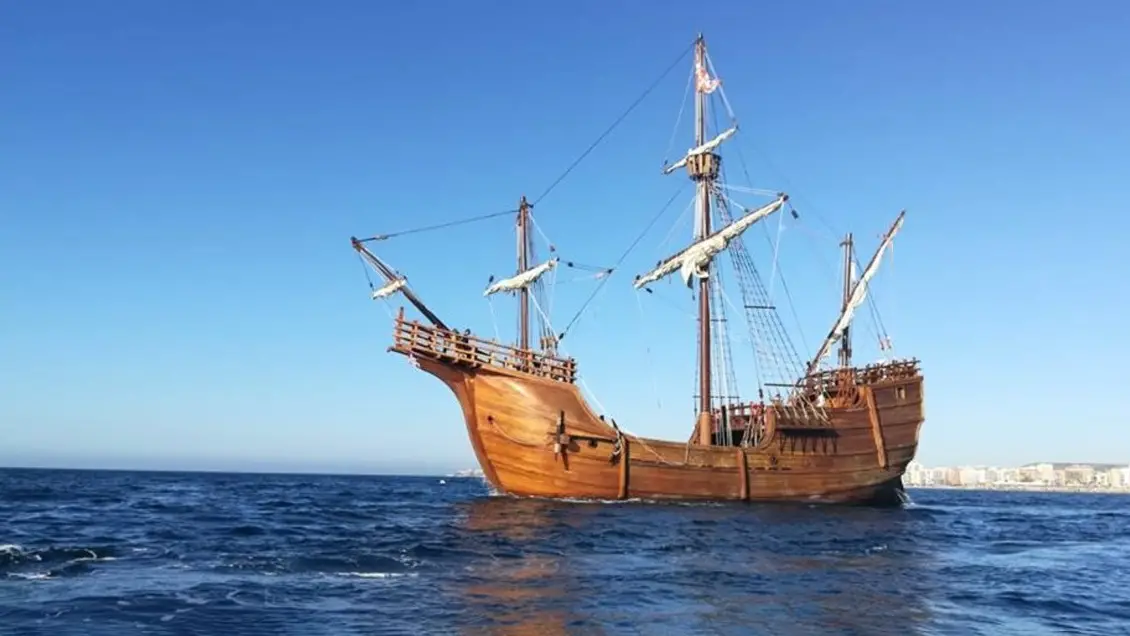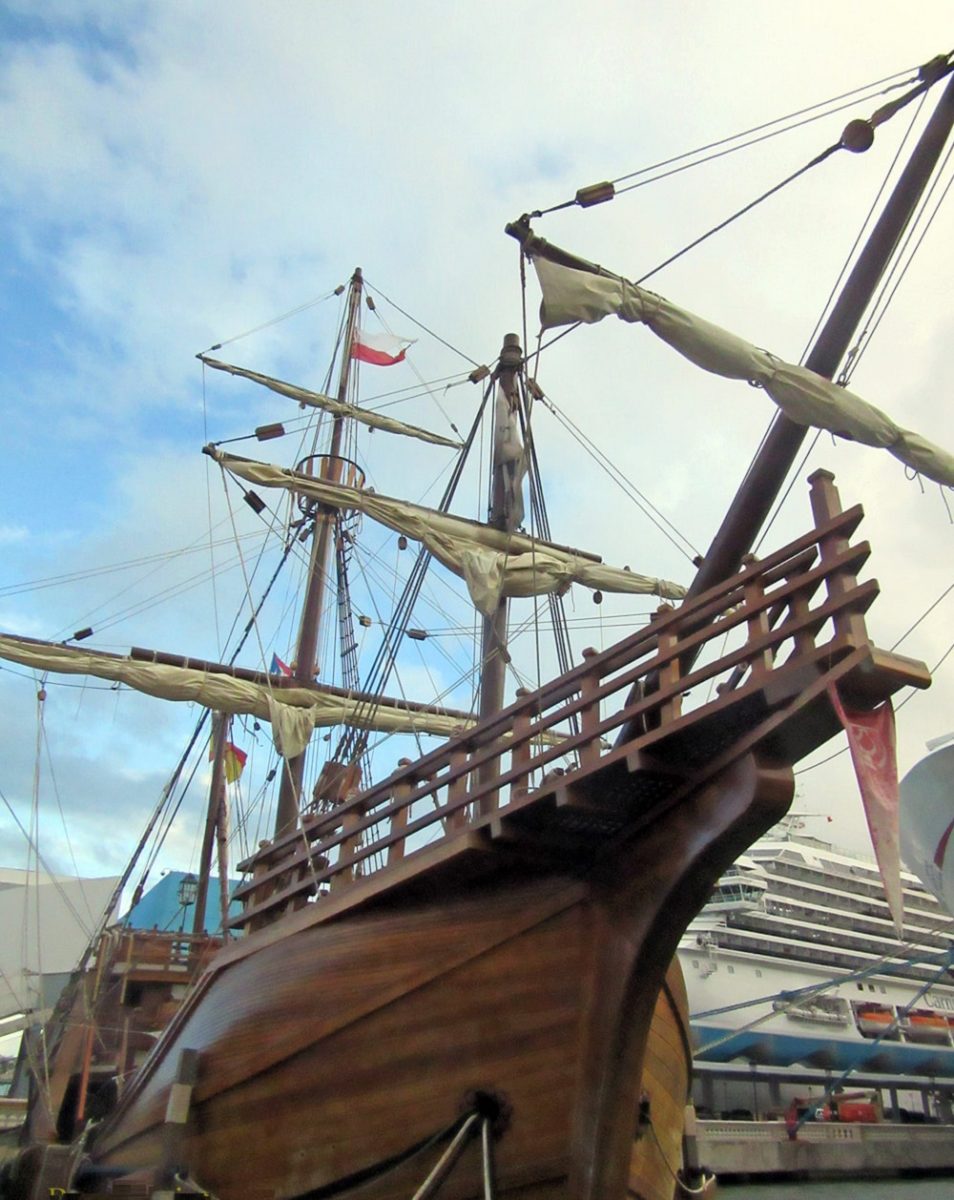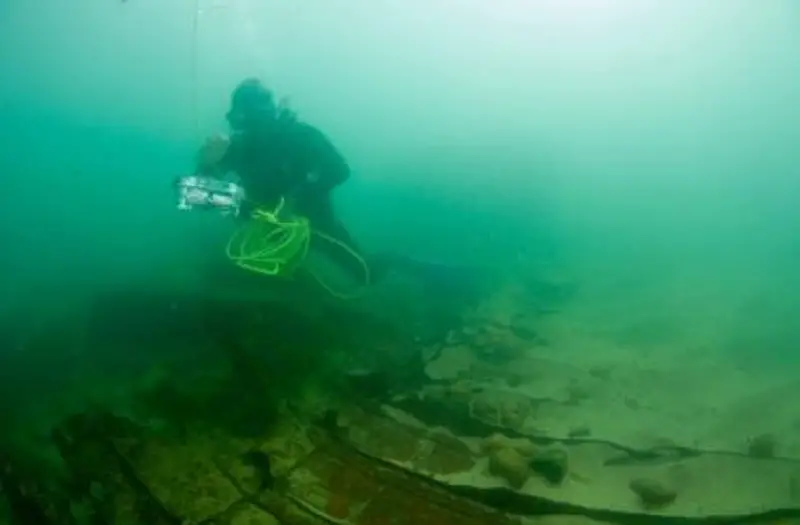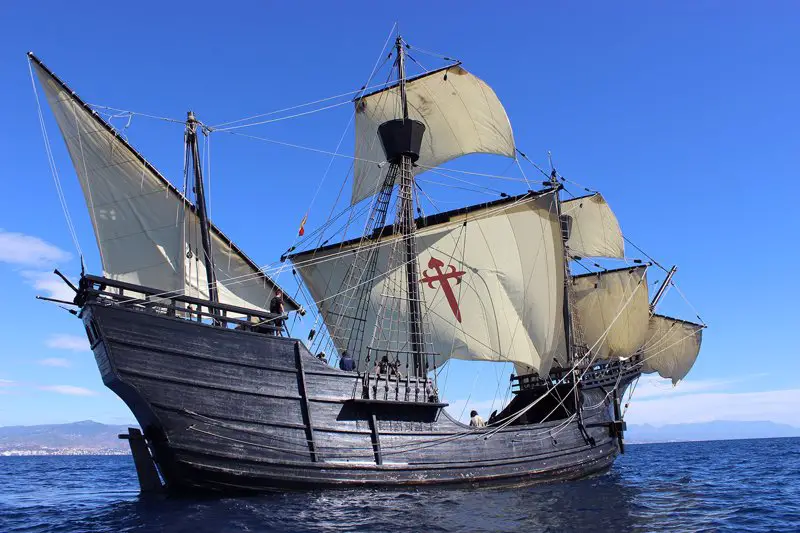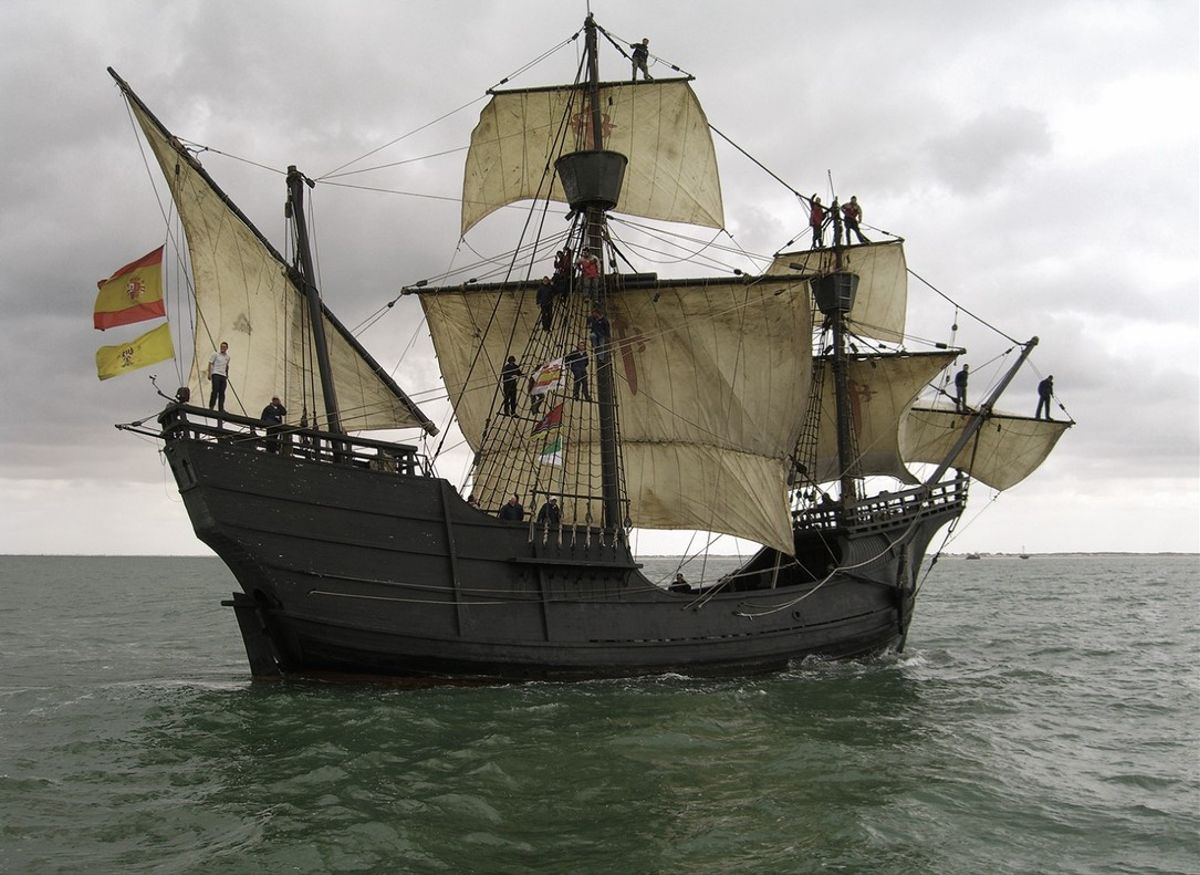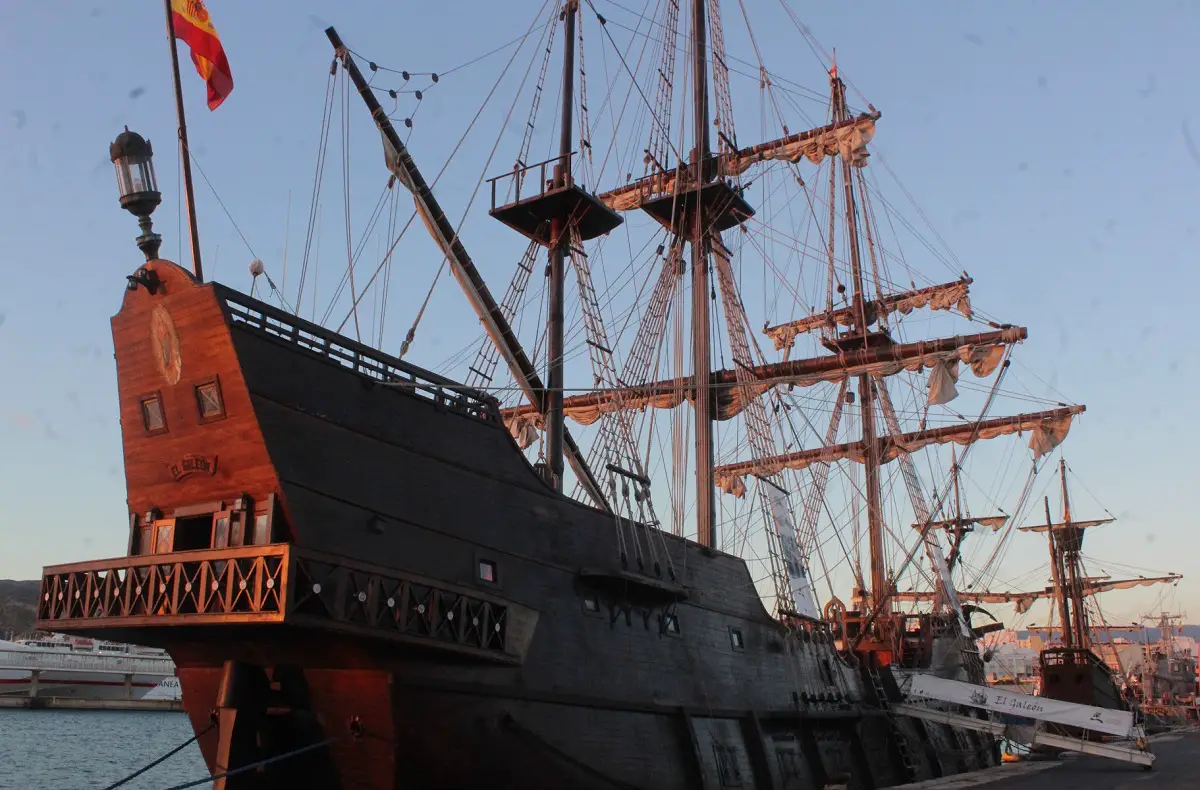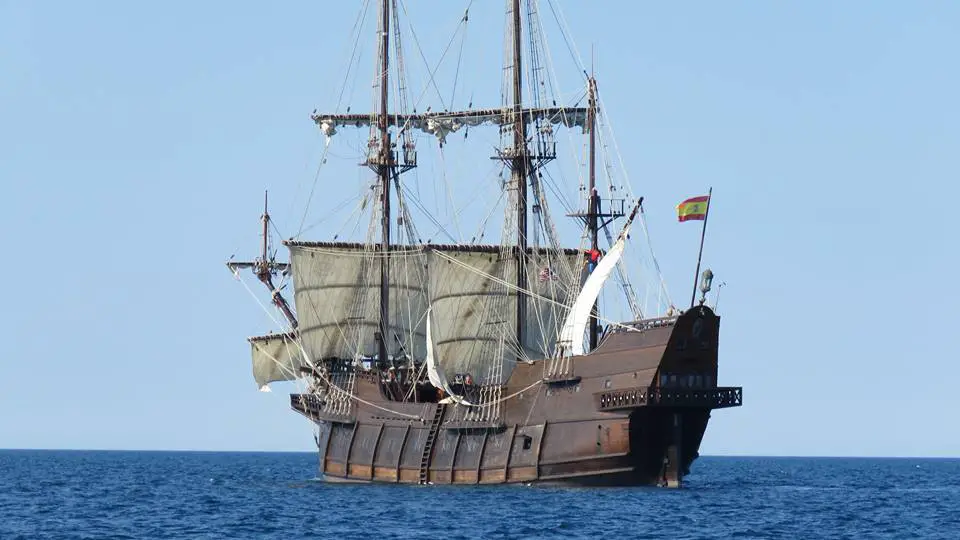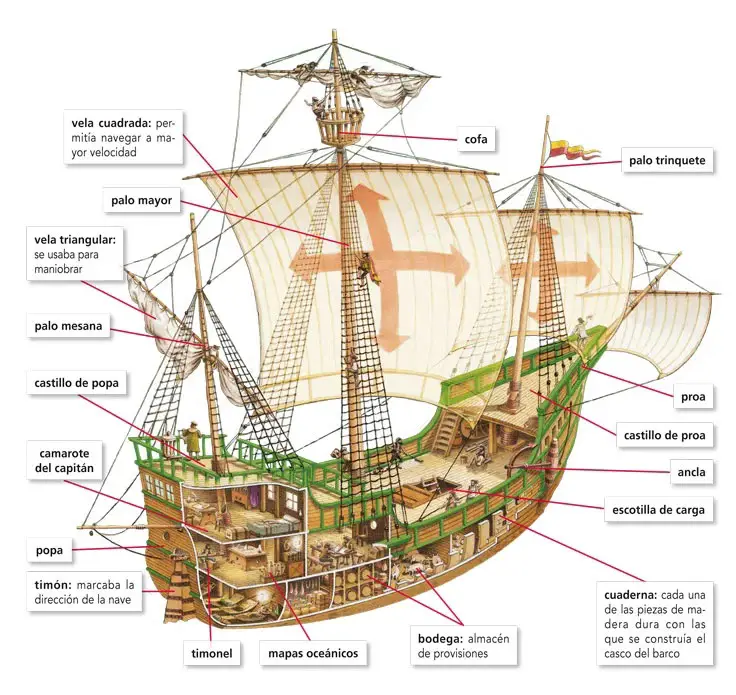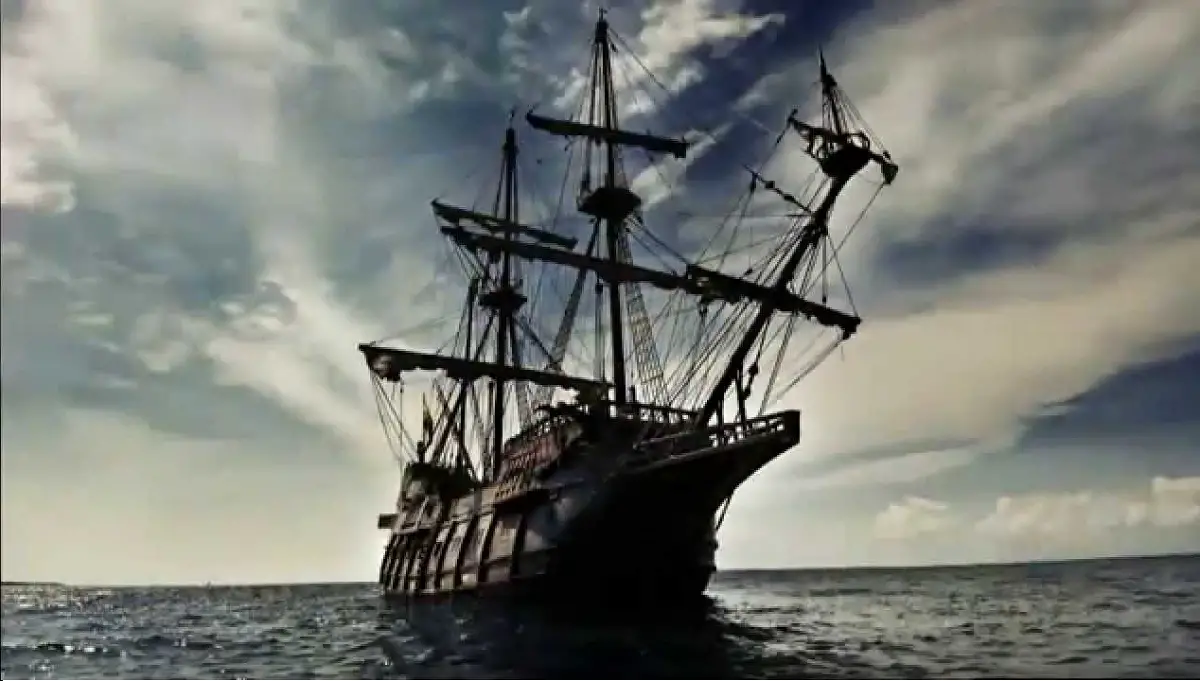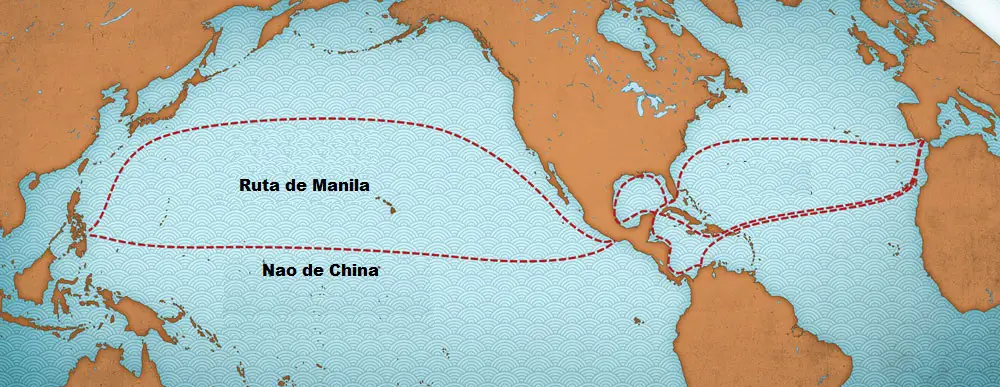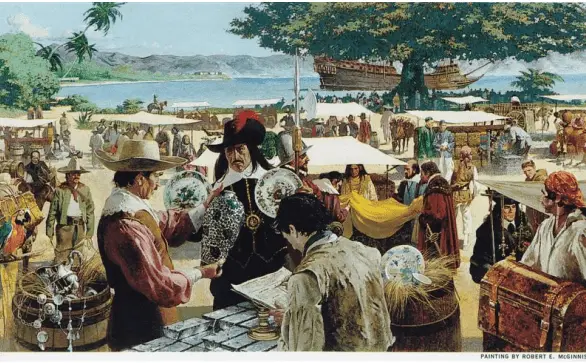The nao was a large ship, originally from northern Spain, which came to meet the need for large-capacity vessels in the Middle Ages. We invite you to learn about its history, the first constructions made, what they were used for, their evolution and their most outstanding characteristics.
Indice De Contenido
What is a nao?
The nao was a large ship in widespread use from the 14th to the 17th centuries, replacing its predecessor, the coca, which had been the most common sailing merchant ship of the preceding years and was limited in its ability to carry large cargoes.
The nao, on the other hand, had a more solid hull and spaces suitable for storing and transporting large quantities of goods. In addition to the usual one or two masts plus foremast with square sails, the new bowsprit mast and the structures of the foremast and stern were features that allowed longer voyages.
On the other hand, the ship’s freeboard was higher, with square sails in the fore and aft forecastles.
The freeboard of the nao was the distance measured vertically amidships from the intersection of the upper surface of the deck with the outer surface of the plating to the corresponding waterline.
The nao originated in the north of Spain, in the region of Cantabria, where it was developed in response to the growing need for ships with more hold space to accommodate the large quantities of goods to be transported as a result of the increase in maritime trade.
The nao has been designed with all features to keep the draught as low as possible. Information on similar ships can be found under Types of ships.
It is therefore right to point out that this ship was a response to the evolution in shipbuilding that was taking place, as a result of the expertise of the carpenters of the time, who were improving seaworthiness, stability, speed and storage capacity.
This ship was mainly used during the 15th and 16th centuries, a period in which hundreds of maritime expeditions were carried out, exploring the new territories that were being discovered and sailing the oceans of the planet. It can therefore be said that the nao played a fundamental role in the Age of Discovery.
It was a ship that marked a milestone in transoceanic navigation, being the first ship to maintain an important maritime trade thanks to the arrangement of its sails and tonnage.
For more information on this subject, see The World’s Largest Ships.
History of the nao
The development of the nao was influenced by the Italian nautical types of the Mediterranean that existed at the time, as well as the Portuguese and Catalan coastal sailing ships, and in particular the Nef ship from north-west France, which was the preferred commercial transport ship of the Christian warriors, mainly from Western Europe, who took part in some of the medieval crusades in the 11th and 12th centuries.
The latter type of single-masted ship was very common in the Middle Ages, especially along the coasts of Western Europe and in the confederation of towns in southern England known as the Five Harbours.
In the 14th century, the nao sailed mainly as a two-masted ship, and later, with improvements, as a three-masted ship.
The naos were narrower and shorter than the familiar cocas, and had a less favourable hull shape, but compensated for this with side-to-side planking, called “kraweel” or caravel construction, and continuous sides. They were also much lighter and cheaper to build.
The nao has often been confused with the carrack, which was also an important type of Mediterranean sailing ship in the late Middle Ages and early modern period.
The authors Alfred Dudszus and Alfred Köpcke, for example, refer in their Great Book of Ship Types to the Portuguese shipwright F. Oliveira, who already in the mid-15th century pointed out that the Portuguese ratchets, the Luso-Spanish naos or ships and the holk or hulk of the Hanseatic League and northern Europe were very similar ships.
However, there are characteristics of the nao that distinguish it from the carrack, such as its stability, seaworthiness, light displacement and stowage capacity.
In the Naval Museum in Rotterdam, Holland, there is a model of a Catalan nau from around 1450, an important testimony to the development of this type of ship, in which the characteristics of the nau can be seen.
Wreck of a merchant ship
The study of a sunken nao, the Nossa Senhora dos Mártires, has provided a great deal of information about naos.
It concerns an event that took place in 1606, when this nao, Nossa, sank off the coast of Lisbon on its way back from India after nine months at sea. It had a hull of 40 metres and a beam of nine metres.
At the time of the incident, it was carrying a cargo that was the main purpose of the voyage: 250 tonnes of peppercorns, plus many other spices and drugs, countless bales of cotton and silk cloth of all sizes and colours, furniture, porcelain, exotic animals and thousands of luxury items from the workshops of the Far East.
The ship also carried 450 people, including crew and passengers, food and water for six months, spare parts and accessories.
First constructions
Among the first and most famous ships in history was the nao Victoria, one of the five ships that set out on the expedition led by Ferdinand Magellan, the only one to return from such a long voyage around the world.
Less well known, but equally famous in their time, were the ships of Juan de Lezcano, a sailor from Guipuzcoa, Captain General of the Navy during the reign of the Catholic Monarchs, who in 1490 was in charge of a fleet of ships in Seville to guard the Spanish Straits, organised as part of the final attack on the Kingdom of Granada in 1482.
Equally important are the ships of Machín de Rentería or Guipúzcoa, General of the Ocean, with which he faced the artillery attacks of the enemy in different circumstances, demonstrating the strength of the ships.
The Victoria
The nao Victoria was the first ship to successfully circumnavigate the world. It was part of a Spanish expedition commanded by the Portuguese explorer Ferdinand Magellan, who was later replaced by Juan Sebastian Elcano after his death in the Philippines.
The expedition began on 10 August 1519 and involved five ships. However, the Victoria was the only ship to complete the voyage, returning to Portugal on 6 September 1522.
The ship was built in a shipyard in Ondarroa, the Basques were renowned shipbuilders at the time, and was given to Magellan along with the other four ships by King Charles I of Spain, the Holy Roman Emperor Charles V.
The ship was 27 metres long and 7 metres wide, and it was thanks to her that the waterway around the southern tip of the South American continent was discovered.
The nao Victoria was named after the church of Santa María de la Victoria de Triana in Seville, where Magellan swore an oath of allegiance to Charles V. It was an 85-ton ship with a crew of 42.
The other four ships were
- Trinidad of 110 tonnes and crew of 55
- San Antonio of 120 tonnes and crew of 60
- Concepción of 90 tonnes and crew of 45
- Santiago of 75 tons and crew of 32.
The Trinidad, which was Magellan’s flagship, the Concepción and the Santiago were wrecked or sunk, while the San Antonio abandoned the expedition during the crossing of the Strait of Magellan and returned to Spain alone.
The Victoria was a nao, like all the others, except the Santiago, which was a caravel.
The voyage began with a crew of around 265 men aboard five ships, but only 18 men returned to the Victoria alive, while many others deserted.
Many of the men died of malnutrition. At the start of the voyage, Luis de Mendoza was their captain. On 2 April 1520, after establishing a settlement at Puerto San Julian in Patagonia, a violent mutiny involving three captains broke out, but was eventually put down.
It is reported that Luis de Mendoza and Gaspar Quesada, captain of the Concepción, were executed and their bodies hung from gallows on the shore.
Under the command of Duarte Barbosa, the Victoria participated in the discovery of Chile, being the first to explore the region in 1520, discovering or naming Patagonia, Cape Virgins, the Strait of Magellan, Tierra del Fuego, the Pacific Ocean and other landmarks.
It is one of the most famous ships in the history of navigation.
What was it used for?
This ancient ship was mainly used for trade to destinations far from the coasts of Europe.
Due to its sturdy construction and large size and weight, it was essential for transporting a wide variety of goods.
It was also used for coastal defence, as its structure could accommodate cannons and even entire cavalry troops, as required for naval defence.
Its hull was dominated by a bulbous shape, which allowed a large carrying capacity, and a high bulbous rim, which provided protection.
Improvements over time
The changes made to the nao were introduced gradually towards the end of the Middle Ages, with many of them taking effect from the 14th century.
The most obvious and beneficial improvements were a greater number of masts, more sail and the addition of lateen sails to the mizzenmast.
The result was greater strength and carrying capacity, making the ship one of the most solid vessels to be used with greater reliability on the sea routes of the growing trade.
The aim was to take advantage of the movement of goods being produced as far away as Iceland in the north, the Azores in the west and even the transport of goods from the African coasts to the Indian Ocean in the south.
Other changes were also introduced, such as forward and aft castles to provide accommodation for passengers and key crew members.
The number of decks was also reduced and increased during the 16th century to accommodate a greater quantity of goods from the Orient.
The strength that the nao acquired through the innovations it incorporated allowed European trade power to be consolidated, not only in the Mediterranean and the Baltic, but also in the new territories that were being discovered in this age of exploration.
In the European environment, the most important countries such as Holland, Spain and Portugal, among others, became stronger and, thanks to the discovery of the territories of the New World by Christopher Columbus, they could count on sufficient resources to build bigger and better ships, which made it easier to continue exploring and discovering new lands.
The changes made to the naos strengthened their position as exploratory and trading vessels, which would later lead to the creation of a new type of ship called the galleon, of which the Spanish and English galleons were the most prominent.
Characteristics of the nao
The main characteristics of the nao are as follows
- It was a large ship.
- It could be used for both trade and war.
- It had high platforms fore and aft from which it could fire at its enemies in the event of war.
- It could be armed with cannons.
- It had square sails for more sail area.
- More room for large payloads.
Its technical specifications were
- Year of creation: circa 1490
- Origin: Spain
- Main area of use: Portugal, Atlantic and Mediterranean.
- Length: 21.50 m
- Breadth: 8.3 m
- Type of propulsion: Sails
- Sail area: approx. 300 m²
- Load capacity: approx. 200 t
- Speed: approx. 11 km/h
- Loading tonnage: from 150 to 500 tonnes.
The ship had a quarter deck, fore and aft forecastle, good freeboard, high superstructures and a large hold.
Because of the need to keep the draft as shallow as possible, the ship’s maximum beam was almost at the waterline.
This necessitated a narrowing of the beam on the main deck and even more so on the forecastle, quarterdeck and forecastle.
The main and forecastle masts were square rigged, while the mizzen mast had a lateen sail.
Among the characteristics that the nao inherited from the cocas were: the round hull with the rudder at the stern and the stern cradle, although its power and therefore its performance were greatly improved.
The number of masts was increased, including the bowsprit that protruded from the forecastle.
It had a fairly high freeboard and the sails were square, with a length to width ratio very similar to that of the Ratchet.
The maximum beam was practically at the waterline, which forced them to narrow the beam on the main deck and even more on the forecastle, quarterdeck and sterncastle.
The main and fore masts were square rigged, while the mizzen had a lateen sail.
The Hull
The hull was the watertight structure of the ship, above which there might be a deckhouse or some other form of superstructure, such as a mast. The line from the hull to the surface of the water was called the waterline.
It consisted of wooden planks supported by transverse frames, often called ribs and bulkheads, joined by longitudinal stringers or decks.
This important frame, which was mostly submerged, allowed the ship to float and manoeuvre properly. It was characterised by a ratio of about 3 between the length and breadth of the ship.
The entire hull structure supported the large deck of the ship on which the forecastle rested, forming an integral part of it, unlike other ships on which the forecastle was superimposed.
The hull deck was designed to accommodate the forecastle and the forecastle with its cargo hatch. It was located between the mainmast and the foremast.
The hull was reinforced with bulárcamas, which were thick, wide wooden strips that made up the hull.
Rigging
Rigging, sometimes called rigging in nautical circles, refers to all the parts associated with masts, spars, sails and other devices that allow the ship to move.
Specifically, it consists of
- Fixed masts
- Shrouds or thick cables that support and hold the masts or spars
- Spars or beams from which sails are suspended
- sheets or ropes attached to each fist of the sails
- Pulleys or sheaves through which the sheets are passed for lashing the sails.
- Fittings when attached to masts and spars and to that part of the running rigging necessary for handling the sails.
Historians note that the first ships were built with a single mast, so their rigging was simpler.
Over time, in the mid to late 15th century, certain improvements were made, including three main masts, which included maststays, some of which were fitted with cofas.
These cofas were the round platforms at the top of the masts that were used as lookout posts, where the lookout, the person in charge of watching the horizon, had to warn of any danger, a nearby enemy ship, the proximity of the coasts, among other things, in order to help the ship manoeuvre.
The structure of the sails of 15th century ships included the following elements
- Bowsprit, which was the mainsail held under the bowsprit mast, which was the mast that came out of the bow with a certain horizontal inclination, but protruding upwards.
- Quartersails for the foremast of the foremast and the topsail, which is the topsail or sail placed on the foremast.
- Quartersails for the mainmast and topsail.
- Mizzen Mizzen lateen sail.
Rigging
The rigging of a ship is made up of the masts, or trees in nautical jargon, and the spars that support all the sails.
It was an essential part of the ship, as the correct configuration of these trees and rods would ensure the correct and expected navigation, as they were the ship’s means of propulsion.
The rigging allowed the ship to move, taking advantage of the air currents to propel itself.
The wind force of the wind is transmitted to the sails, which must be perfectly attached to the rigging in order to transfer this impulse to the hull.
All the weight of the rig is mainly supported by the masts and spars, which together allow the sails to catch the wind, so that the ship can move to its fullest.
The rigging, consisting of ropes and ropes, also plays an important role.
Trading ship from China to America
In the annals of merchant shipping, the nao de China is recorded, thanks to which exotic goods from the East were transported to the American continent.
Such an event dates back to the time when Spain consolidated its expansion into the new territories discovered by Christopher Columbus in America. The Spanish, after dominating the Mexican lands to the west and the Philippines to the east, became a vast nation with lands beyond the seas.
In addition, Spain already had part of its territory in the eastern part of the world, which made it possible to establish a maritime trade route from China via the Philippines and from there via western Mexico to the New World, taking its products to the port of Acapulco on the Pacific coast.
The so-called “Manila Galleon” or “Nao de China” was used to successfully complete this route.
It is worth remembering that when the stories of Marco Polo reached Europe, there was an obsession to get to know these distant lands of the Orient.
Marco Polo revealed that there was a great trade route between the Sahara and northern China, rich in exotic goods such as food and spices, as well as objects and clothing such as silk.
Spices, for example, became great delicacies, worth more than gold itself.
This became the most important trade route, known as the Silk Road, which extended to the whole of Europe and became a route of cultural exchange that lasted until war broke out between Christians and Muslims, preventing the passage of the caravans.
Later, the Portuguese took control of this spice route, which passed through the Cape of Good Hope in southern Africa, continued through Ceylon, reached several Chinese cities and the Moluccas, known as the Spice Islands.
With the dominance of this route, Portugal gained commercial supremacy until the Manila Route appeared.
This route, which started in the Philippines, took the Nao de China to Japan to take advantage of the Alaskan current that flows from Asia to Japan.
Once there, the current from Alaska to California was used as an impulse to reach the west coast of Mexico, skirting that side of the continent to pass through the various ports that had been established to supply the nao with food and water.
The last port before the return was Acapulco, where the nao unloaded all its goods.
From there, some was distributed to Mexico City, some to the port of Veracruz and some to Spain.
The ship’s voyage became a tradition, as the goods were transported from the ports on the backs of mules, arriving in Mexico City on the day of Corpus Christi, which was already known as Mule Day.
It was a special moment of commemoration and celebration for the city, which organised a special market to sell the goods, as the objects that arrived were of great value and highly prized.
The voyages of this ship continued for many years, although they had to be interrupted in 1815. Nevertheless, the Thursday of Corpus Christi is still celebrated in Mexico City as the Day of the Mulitas, commemorating the arrival of the nao’s goods from China.

